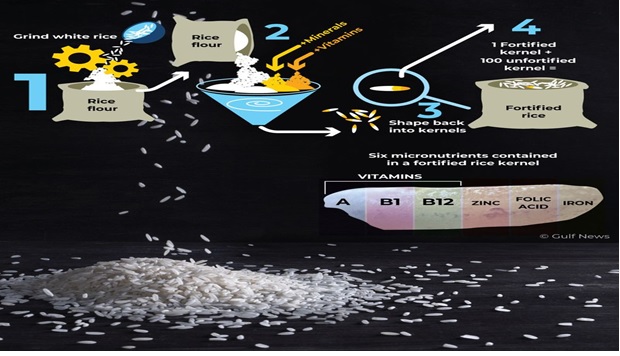Home » The fortification of whole grain rice as a potential remedy for micronutrient deficiency

The fortification of rice is a viable and cost-effective approach to enhance the consumption of essential micronutrients in nations where rice serves as a fundamental dietary component. An effective fortification approach should provide significant amounts of micronutrients, have high bioavailability, exhibit stability during storage, and maintain sensory qualities. Diets in developing nations mostly consist of cereal-based products. They only provide the daily needs for several important elements and are lacking in micronutrients. As a result, those who are deficient have a number of issues with public health that are caused by single or multiple nutritional deficiencies.
This includes iron deficiency which causes anaemia, zinc deficiency which causes malnutrition, poor quality pregnancy, and low birth weight, vitamin A, folate, vitamin B12, omega-3 PUFA (Poly Unsaturated Fatty Acid), and vitamin D deficiency, all of which result in a variety of deficiency disorders.The targeted micronutrient has been added to rice using a variety of approaches. These technologies may be roughly categorised as fortified flour extrusion, whole-grain fortification, and genetic approaches.Rice is enriched via the flour extrusion process without the complete cereal grain being lost. Here, broken rice is first ground into a powder and combined with fortifiers.This material is then extruded and reconfigured into rice. Finally, rice analogues are desiccated and used to make fortified rice.In addition, numerous attempts at fortification have been made to preserve the rice grain. Collectively, these are known as whole-grain fortification technologies.
Fertilisation is an agricultural practise that involves the addition of specific salts of micronutrients to the soil as a means of fortification. Initially, the soils were subjected to the application of normal fertilisers including nitrogen, phosphate, and potassium. Subsequently, rice seedlings at the age of 21 days were planted.
Rice can also be fortified with micronutrients by immersing in a fortificant solution and then dehydrating at 40–50 °C. Zinc enrichment was accomplished by immersing paddy in a zinc sulphate solution (0 mg/L to 250 mg/L) at 30 °C for 10 hours. Germination decreased phytic acid levels, resulting in increased bioavailability.
Food extrusion is a prevalent method used in the creation of snacks, morning cereals, and texturized vegetable protein. This process involves subjecting the food to high temperatures for a brief duration, sometimes referred to as high temperature short time (HTST). Rice fortification is widely recognised as the most common and extensively used technique.
The potential harm resulting from excessive intake of fortificants might provide a significant risk to the individual. Therefore, it is essential to implement stringent regulations on the production of fortified goods.Despite significant advancements in the fortification of whole-grain rice, there is still a need for major improvement in the quality of the final product, as well as the prevention of micronutrient loss throughout subsequent processing stages. The enhancement of micronutrient content in rice may be achieved by the process of whole grain fortification. Various research, both historical and modern, have shown that fortified grains have the ability to effectively address deficiencies in micronutrients, hence resulting in considerable benefits.
Conclusion
The fortification of a widely consumed grain such as rice has the potential to effectively reduce the prevalence of certain micronutrient deficiencies among the global population. The fortification of food products has the potential to significantly increase the levels of several micronutrients, such as vitamins A, B, C, and minerals Fe, Zn, Se, and Ca.
Dr. Swapnila Roy
HOD,SOBAS
September 1, 2023RECENT POSTS
CATEGORIES
TAGS
Agriculture Agriculture future AI Architecture artificial intelligence BA English BA Psychology BTech CSE BTech Engineering Business management career Career-Specific Education career guide Career Opportunities career option career scope Civil engineering commerce and management Computer Science Computer science engineering Data science degree education Engineering Engineering students English Literature english program Exam tips Fashion Design Fashion design course Higher Education Journalism journalism and mass communication law Law career Machine Learning MA Psychology Master degree mathematics MBA Mechanical Engineering Pharmacy Psychology Research and Development students
University Address: Nachauli, Jasana Road, Faridabad, Haryana
Toll Free: 1800-120-4613
Mobile : 8447744303 | 8447744304 | 8447744306 | 8447744309
Address: C-72, Second Floor, Shivalik, Near Malviya Nagar,
Above HDFC Bank, New Delhi 110017
Ph.No. - 011-46570515 / 45138169 / 41755703 / +91-7303152412
Jagmani Kutir, Ground Floor, Road No-1, Rajeev Nagar,
Near Darbar Marriage Hall, Patna-800024, Bihar
Contact No: 9818352069/8130120095
Mail: [email protected]
Copyrights © 1998 - 2025 Lingaya's Vidyapeeth (Deemed To Be University). All rights reserved.
It is important to note that the following email IDs and domains are fraudulent and do not belong to our university.
LV only conducts physical/online verification of any document related to examination on the following email id: